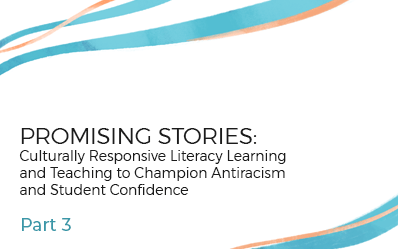Promising Stories, Part 3: Culture Connections & Build on Students’ Strengths
This is the third in a multi-part series by Laura Benson, ISS Director of Curriculum and Professional Development. Find other installments here: Part 1, Part 2, Part 4, Part 5, and Part 6.
Promising Stories: Culturally Responsive Literacy Learning and Teaching to Champion Antiracism and Student Confidence
Relevance and meaningfulness rely on being able to make personal cultural associations.
Yvette Jackson
Culture Connections
Help students use their cultures before, during, and after reading a text or learning a content area unit of study. Culture includes wells of schema or background knowledge such as family rituals and routines for daily life, celebrations, and rites of passage; spiritual learnings; ethnic heritage stories and traditions; background knowledge and experiences.
Culturally Responsive Learning Strategies:
SPEAK THE LANGUAGE OF UNDERSTANDING
Encourage students to self-talk with language such as “This reminds me of…” and “This is like ____ because…” and “This feels just like…because…” as well as “This is different from my own experiences/ family/beliefs/traditions because
CONNECT 2
Before or after students read, view or do, post a few key vocabulary concepts and ask them to make connections between the terms. As a “before” learning activity, students will be drawing on their background knowledge and curiosity to develop inferences about the connections. As an “after” activity, Connect 2 is a powerful and efficient way to help students process and retain (Jensen) their reading, viewing, and/or doing. Support students’ thinking with a stem such as “I would connect ____ and ____ because…” As students become more sophisticated, additional connections can be encouraged (Students may need or want to connect three or four terms. The key ingredient is the “because” explanation.).
Culture, it turns out, is the way that every brain makes sense of the world. That is why everyone, regardless of race or ethnicity, has a culture. Think of culture as software for the brain’s hardware. The brain uses cultural information to turn everyday happenings into meaningful events. If we want to help dependent learners do more high order thinking and problem solving, then we have to access their brain’s cognitive structures to deliver culturally responsive instruction.
Zaretta Hammond, Culturally Responsive Teaching & The Brain
Build on Students’ Strengths
Self confidence is success remembered. How do your students learn outside of school? Over the last forty-three years, I observed how my own students learned beyond our classroom and now, as a guest/demonstrating teacher for colleagues in countries around the globe, I continue to pay attention to the variety of ways students learn and work to understand the text of our big wide world.
If we want to prepare kids for adulthood, one of the most important things we can do is to celebrate their strengths, those assets with which they’re going to find meaning in life and be able to make contributions (Levine). Focus on what students can do now. Consider how their strengths can bridge confidence and competence in ministering to their needs.
To have that sense of one’s intrinsic worth is potentially to have everything.
Joan Didion
Culturally Responsive Learning Strategies:
- Confer with students regularly to know their strengths, passions, questions, concerns, etc. Name the strengths and approximations you notice (Often, students do not “see” or know that they are using any effective strategies. Your lens can help students stay focused on what they are doing well so that they will replicate these behaviors and build up their confidence to “have a go” in new learning contexts.). Ask students to identify what they do well as readers, writers, mathematicians, artists, thinkers, etc. during conferences.
- Name students’ strengths when you meet with them in small groups, during whole group discussions, from your conference insights, etc.
- Create a ritual such as a Native American Talking Circle. Encourage students to name their own strengths by asking them a question such as “What did you learn about yourself as a reader/thinker/problem solver/writer/etc. today?” (Taberski) or “Name something you did well today/are proud of today (including being a character learning such as being a kind friend, staying engaged in a “hard” reading text, working with resilience when trying a new revision tool, etc.).
- Interview and/or survey students and parents about the children’s strengths.
- Use a student’s strength to minister to his/her need. For example, if a student is a successful fiction reader but a reluctant or struggling nonfiction reader, engage the student in reading in autobiographies or biographies. This way he/she can bring successful fiction strategies and confidence to his/her reading of these narrative nonfiction texts…and, over time, you can mentor the reader to better understand how and why to read nonfiction texts well and joyfully (or, at least, purposefully).
Strong is what we make each other.
-Marge Piercy, Author and Poet
All installments of the Promising Stories series can be found here:
- Part 1: Introduction
- Part 2: It Starts With Stories…Your Stories, My Stories, Our Stories
- Part 3: Culture Connections, and Build on Students’ Strengths
- Part 4: Reflection, and Outside Learning as an Avenue for Inside Learning
- Part 5: Books are Mirrors and Windows
- Part 6: It’s All About Relationships
View References and Resources for Developing Culturally Responsive Learning and Nurturing Antiracism
You can also follow Laura at @lbopenbook, plus view her curated antiracism padlet here.

